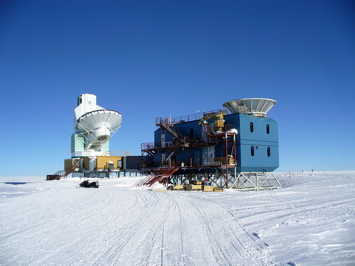Cosmic Inflation: It Really Happened
In March 2014, a South Pole research team reported that BICEP2 had detected gravitational waves and definitively proved that the universe experienced hyper-expansion (an inflation event) when it was extremely young.1 Such a momentous discovery, everyone agreed, was worthy of a Nobel Prize; however, it was not to be. In their zeal to be the first to find gravitational waves, the research team mistook a signal from cosmic dust for “primordial gravitational waves.” (See RTB’s coverage of the inflation drama here and here.)
The BICEP2 team’s confession that they had jumped the gun in announcing their “discovery” of gravitational waves led to several expressions of distrust of the scientific enterprise. It also caused many Christian writers to conclude that cosmic inflation is a myth and that the big bang theory is not all it is cracked up to be.2 These reactions motivated the BICEP2 team to release a paper in which they cautioned lay authors not to throw out the baby (inflation and the big bang creation model) with the bathwater (their premature announcement of discovering gravitational waves).3
The BICEP2 telescope is designed to detect the B-mode polarization signal of the cosmic microwave background radiation (CMBR), the heat radiation that remains from the cosmic creation event. Once the background noise from cosmic dust is removed and, assuming the remaining signal is strong enough to be accurately measured, this B-mode signal will reveal to astronomers whether the universe experienced an inflation event very early in its history, and, if it did, exactly what kind of inflation event it experienced.
It turns out, however, that astronomers do not need the B-mode signal to prove whether or not the universe had an inflation event; that is possible with just the E-mode polarization signal. The E-mode signal is sufficient to determine the scalar spectral index (ns) of the CMBR spectrum. For a universe with no inflation event, ns equals 1.0 or greater. For a universe that had a simple inflation event, ns equals exactly 0.95. For a universe that has had a complex inflation event, ns equals 0.96–0.97.
Another telescope at the South Pole, the South Pole Telescope (see figure 1), is designed to measure the E-mode signal. The South Pole Telescope (SPT) research team just published their latest measurements.4 Their measurements, in combination with the best results from the WMAP and Planck satellite, have yielded the most accurate determination of ns to date. The value they published: ns = 0.9593 ± 0.0067.5

Credit: Ample (Creative Commons)
The error estimate (± 0.0067) is what statisticians call the standard deviation. The SPT team proved the reality of cosmic inflation to 6.075 standard deviations—(1.0 – 0.9593)/0.0067. That number of standard deviations translates into a certainty measure for the reality of cosmic inflation. In light of the team’s measurements, we now can be 99.9999999 percent certain that the universe indeed went through an inflation event when the universe was only about 10-34 seconds old. To put it another way, there is less than 1 chance in 900,000,000 that the universe did not experience an inflation event very early in its history.
Thanks to the SPT team’s efforts, the big bang model has passed yet another test. Its prediction of a cosmic inflation event has proven correct. This is good news for Christians because for more than 2,500 years the Bible and biblical commentaries were the only books proclaiming the fundamental features of big bang cosmology:
- A singular beginning of matter, energy, space, and time (Genesis 1:1; 2:3; 2:4; Psalm 148:5; Isaiah 40:26; 42:5; 45:18)
- Ongoing expansion since that beginning (Job 9:8; Psalm 104:2; Isaiah 40:22; 42:5; 44:24; 45:12; 48:13; 51:13; Jeremiah 10:12; 51:15; Zechariah 12:1)
- Constant laws of physics (Genesis 1–3; Ecclesiastes 1, 3; Jeremiah 33:19–26; Romans 8:18–23; Revelation 21)
- A pervasive law of decay that implies a continuously cooling cosmos (Romans 8:18–22)
Owing to a multitude of observational verifications of the big bang creation model, Christians possess a powerful tool for demonstrating the inspiration, inerrancy, and predictive power of the Bible.
In the near future, I think that the South Pole telescopes and the Planck satellite will produce even more accurate B- and E-mode polarization measurements of the CMBR. These results will tell us what kind of inflation the universe has experienced. That knowledge may reveal some new cosmic design features that could further strengthen the scientific case for a personal God who created and designed the universe for the specific benefit of human beings.
Endnotes
- Ron Cowen, “Telescope Captures View of Gravitational Waves,” Nature 507 (March 2014): 281–83, doi: 10.1038/507281a; Ron Cowen, “Gravitational-Wave Finding Causes ‘Spring Cleaning’ in Physics,” Nature News, posted on March 21, 2014, doi: 10.1038/nature.2014.14910.
- Jake Hebert, “Another Big Bang Blunder,” Acts and Facts 43, no. 9 (September 2014), https://www.icr.org/article/another-big-bang-blunder; Brian Thomas, “2014 Most Notable News: Big Bang Fizzle,” Institute for Creation Research, posted January 5, 2015, https://www.icr.org/article/a-2014-most-notable-news-big-bang-fizzle; and Danny Faulkner, “Cosmic Inflation Again,” Danny Faulkner (blog), posted on February 2, 2015, https://answersingenesis.org/blogs/danny-faulkner/2015/02/02/cosmic-inflation-again.
- P. A. R. Ade et al., “Joint Analysis of BICEP2/Keck Array and Planck Data,” Physical Review Letters114 (March 2015), doi: 10.1103/PhysRevLett.114.101301.
- A. T. Crites et al., “Measurements of E-Mode Polarization and Temperature-E-Mode Correlation in the Cosmic Microwave Background from 100 Square Degrees of SPTpol Data,” Astrophysical Journal 805 (May 2015), doi: 10.1088/0004-637X/805/1/36.
- Ibid.





